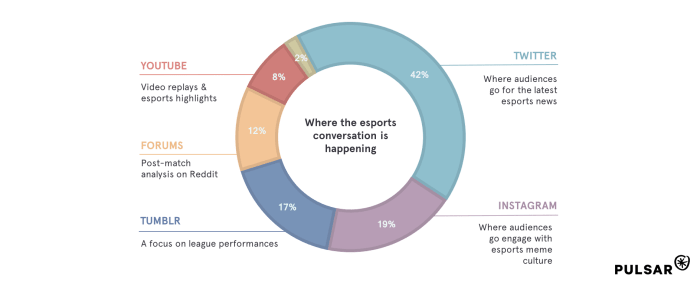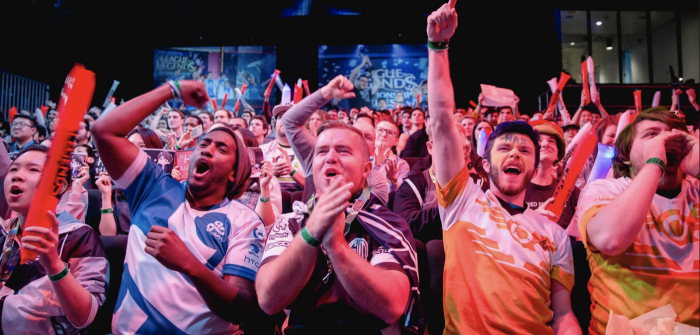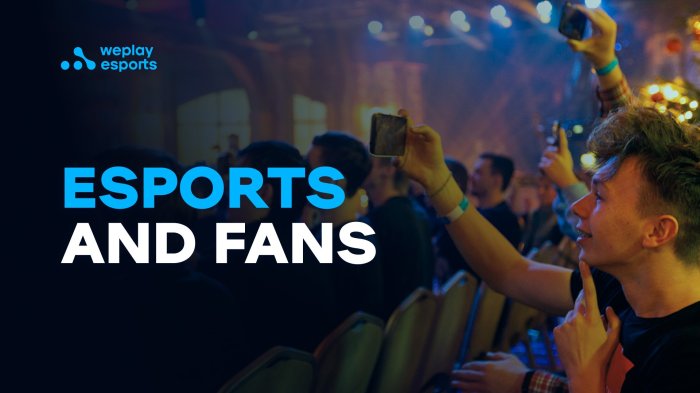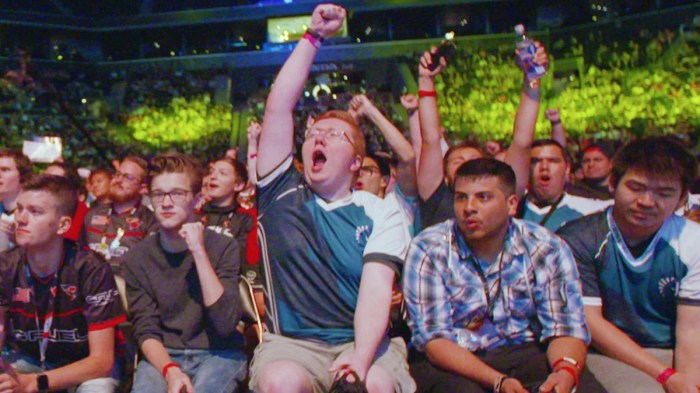Esports Fan Communities are exploding! Forget just watching the games; these passionate groups are shaping the entire esports landscape. From intense online debates on Reddit to collaborative fan art projects on Discord, these communities are vibrant ecosystems of shared experiences, inside jokes, and fierce loyalty. We’ll explore the demographics, online interactions, and cultural impact of these powerful groups, diving into how they’re changing the game—literally.
This exploration will cover everything from the age and location of typical fans to the unique cultures that spring up around different game genres. We’ll examine how esports events fuel community engagement and the role of fan-created content in strengthening the bond between players and their favorite teams. We’ll also look at the challenges these communities face, like toxicity and misinformation, and explore potential solutions.
Finally, we’ll gaze into the future, imagining how evolving technologies might shape the next generation of esports fandom.
Online Engagement and Interaction: Esports Fan Communities

Esports fan communities thrive on online interaction, creating vibrant digital spaces where fans connect, share their passion, and build a sense of belonging. These online hubs are crucial for fostering community spirit, providing a platform for discussion, and ultimately driving engagement with the esports scene. The platforms used and the types of interaction they facilitate vary widely, shaping the overall community experience.Online platforms serve as the lifeblood of esports fan communities, facilitating communication and engagement on a massive scale.
These platforms offer unique features that cater to different aspects of fan interaction, from casual conversation to highly organized events. The success of these communities often depends on the effective management of these online spaces.
Popular Online Platforms for Esports Fan Communities
Discord, Reddit, and Twitch chat are three dominant platforms used by esports fan communities. Discord provides a structured environment with dedicated channels for various topics, fostering focused discussions and allowing for easy organization of events and activities. Reddit, with its subreddit system, allows for broader, more open discussions and the creation of diverse communities around specific games, teams, or players.
Twitch chat provides real-time interaction during live streams, creating a dynamic and immediate engagement experience for viewers. Each platform offers unique advantages, leading to a diverse ecosystem of online fan engagement.
Types of Interactions Within Esports Fan Communities
The interactions within these communities are incredibly diverse. Discussions about game strategies, player performance, and upcoming tournaments are commonplace. Debates on controversial topics, such as rule changes or player controversies, can spark lively and sometimes passionate exchanges. Fans also frequently share fan art, showcasing their creativity and passion through digital drawings, animations, and other forms of creative expression.
This combination of information sharing, debate, and creative expression creates a rich and engaging online environment.
Successful Community Management Strategies
Successful esports organizations understand the importance of actively managing their online communities. They employ strategies such as dedicated community managers who actively participate in discussions, respond to fan inquiries, and foster positive interactions. Regularly scheduled events, such as AMAs (Ask Me Anything) sessions with players or coaches, can create exciting engagement opportunities. Contests and giveaways further incentivize participation and build community excitement.
Transparency and open communication with fans are also key components of effective community management. For example, Team Liquid’s proactive engagement with their fanbase on social media and their well-organized Discord server are prime examples of successful community management.
Hypothetical Social Media Campaign: Engaging the Valorant Fan Community
To engage the Valorant fan community, a hypothetical campaign could focus on user-generated content. The campaign, titled “Valorant Vandalism,” would encourage fans to create and share their own Valorant-themed artwork, edits, and memes across platforms like Twitter, Instagram, and TikTok. Prizes would be awarded for the most creative submissions, judged by a panel of community members and Valorant professionals.
This campaign leverages the inherent creativity of the fanbase, incentivizes participation through rewards, and promotes community interaction through voting and sharing. The campaign would use relevant hashtags like #ValorantVandalism and #ValorantCommunity to increase visibility and encourage cross-platform engagement. This strategy capitalizes on the visual nature of the game and the fans’ inherent creativity to create a fun and engaging campaign.
Community Culture and Identity

Esports fan communities are more than just groups of people who enjoy watching competitive gaming; they’re vibrant, complex social ecosystems with their own unique cultures and identities. These cultures are shaped by shared experiences, inside jokes, and a set of values and norms that bind members together, creating a sense of belonging and camaraderie. Understanding these cultural dynamics is key to appreciating the power and influence of esports communities.The shared passion for a particular game or esports organization forms the bedrock of these communities.
However, the specific expression of this passion varies wildly, leading to diverse and often fascinating community cultures. Memes, inside jokes, and shared experiences act as powerful glue, solidifying community bonds and creating a shared language and understanding. Think of the iconic “PogChamp” emote – instantly recognizable and understood across many different gaming communities. These shared cultural markers contribute significantly to a community’s unique identity.
Key Values and Norms in Esports Fan Communities
Esports communities, while diverse, often share some common values. Loyalty to teams and players is paramount; fans fiercely defend their favorites and celebrate victories with passionate enthusiasm. Respect for skilled gameplay is also a core value; even amidst intense rivalries, many communities appreciate and acknowledge exceptional skill displayed by opponents. A strong sense of community and mutual support exists in many communities, with members often helping each other, sharing knowledge, and offering encouragement.
However, toxicity and negativity can also be present, representing a significant challenge for many communities. These communities are constantly evolving, and their norms and values are constantly being negotiated and redefined by their members.
The Role of Memes, Inside Jokes, and Shared Experiences, Esports Fan Communities
Memes, inside jokes, and shared experiences are the lifeblood of many esports community cultures. A shared understanding of an inside joke can instantly forge a connection between two members, signifying belonging and shared understanding. Memes often act as shorthand for complex emotions or shared experiences, allowing for quick and efficient communication within the community. For example, a specific meme might encapsulate the frustration of a particularly challenging game moment or the joy of a spectacular victory.
Shared experiences, such as witnessing a historical upset or a legendary play, also contribute to a shared sense of identity and community memory. These shared moments are often recounted and reinterpreted within the community, further strengthening the bonds between members.
Comparing and Contrasting Esports Community Cultures
The cultures of different esports communities can vary dramatically. The community surrounding a highly competitive, strategic game like Dota 2 might emphasize analytical discussion and in-depth strategy analysis, compared to a community centered around a more fast-paced, action-oriented game like League of Legends, which may focus more on hype and exciting plays. Similarly, the culture of a community supporting a specific esports organization will often reflect the organization’s brand and values.
Some communities might be known for their positive and welcoming atmosphere, while others might have a more intense and competitive dynamic. These differences stem from a variety of factors, including the nature of the game, the personalities of the players and fans, and the overall culture of the platforms where the community interacts.
Key Elements of a Strong and Positive Esports Community Culture
Creating a strong and positive esports community requires a conscious effort from both organizers and community members. Several key elements contribute to a thriving and inclusive environment.
- Respectful Communication: Encouraging positive and constructive interactions, discouraging harassment and toxicity.
- Inclusivity and Diversity: Creating a space where everyone feels welcome and valued, regardless of background or skill level.
- Active Moderation: Implementing effective moderation strategies to address negativity and ensure a safe environment.
- Shared Goals and Activities: Organizing events, tournaments, and discussions to foster a sense of community and shared purpose.
- Clear Guidelines and Expectations: Establishing clear community guidelines to ensure everyone understands the norms and expectations of the community.
- Open Communication and Feedback: Providing channels for community members to voice their concerns and suggestions.
Fan-Created Content and Participation
Esports communities are vibrant ecosystems fueled not only by professional players and organizations but also by the passionate engagement of their fans. Fan-created content plays a crucial role in shaping the culture, expanding the reach, and ultimately, the success of esports titles and teams. This content reflects the dedication and creativity of the fanbase, acting as a powerful testament to the immersive experience esports provides.Fan-created content encompasses a wide range of creative expressions, reflecting the diverse talents and interests within the community.
This contribution goes beyond simple viewership; it actively shapes the narrative and experience surrounding esports. The motivations behind this creation are varied and deeply rooted in the connection fans feel to their chosen games, teams, and players.
Types of Fan-Created Content
Fan-created content in esports communities is incredibly diverse. It includes visual art like stunning digital paintings and illustrations of favorite characters or players, often showcasing remarkable skill and attention to detail. Animated videos, ranging from short comedic skits to elaborate highlight reels showcasing impressive gameplay, are another popular form. Written content takes many forms, from in-depth match analyses and player profiles to creative fiction stories set within the game’s universe or humorous memes and commentary.
Beyond these, fans create music, cosplay, and even custom game modifications, further enriching the overall esports experience.
Motivations for Fan Content Creation
The reasons behind fan content creation are multifaceted. Many fans are driven by a desire to express their passion and appreciation for their favorite games, teams, or players. Creating art, writing stories, or producing videos allows them to engage with the esports world on a deeper, more personal level. Some fans seek to connect with other members of the community, sharing their creations and engaging in discussions.
Others are motivated by a desire to contribute to the overall esports ecosystem, enriching the experience for other fans. The act of creation itself can be incredibly rewarding, providing a sense of accomplishment and belonging. For some, it’s a way to hone their skills and potentially even pursue a career in related fields.
Impact of Fan-Created Content on the Esports Ecosystem
Fan-created content significantly impacts the esports ecosystem. It expands the reach of esports beyond the core fanbase, attracting new viewers and players through engaging and shareable content. This content also fosters a stronger sense of community, connecting fans with each other and with their favorite teams and players. Furthermore, it can generate significant buzz and excitement around events and tournaments, driving viewership and engagement.
The high-quality content produced by fans can also serve as valuable marketing material for esports organizations, promoting their brands and attracting sponsors. For example, a well-made fan video showcasing a team’s impressive victory could go viral, significantly increasing their visibility and brand recognition.
Leveraging Fan-Created Content for Stronger Community Relationships
Esports organizations can significantly benefit from leveraging fan-created content to build stronger relationships with their communities. They can showcase fan art on their social media channels, highlighting the creativity and dedication of their fans. They can feature fan videos on their websites and YouTube channels, giving fans a platform to share their work and connect with a wider audience.
Running contests and giveaways featuring fan-created content can encourage participation and foster a sense of community. Actively engaging with fans who create content, providing feedback and recognition, can strengthen relationships and build loyalty. For instance, a team might invite a talented fan artist to create official artwork or collaborate with a fan filmmaker to produce a promotional video.
Such initiatives not only celebrate fan creativity but also demonstrate the organization’s appreciation for its community, fostering a more engaged and loyal fanbase.
Challenges and Issues within Esports Fan Communities

Esports fan communities, while vibrant and passionate, often grapple with significant challenges that can detract from the overall positive experience. These issues range from the relatively minor annoyances of excessive negativity to serious problems like harassment and the spread of misinformation. Addressing these challenges is crucial for fostering healthy and inclusive online spaces where fans can celebrate their shared passion.
Toxicity and Harassment
Toxicity and harassment are unfortunately prevalent in many online communities, and esports fan communities are no exception. This can manifest in various forms, from casual insults and flaming to targeted harassment and doxing. The anonymity afforded by the internet often emboldens negative behavior, and the highly competitive nature of esports can exacerbate these issues. For example, intense rivalries between teams can lead to fans engaging in personal attacks against players or other fans.
The emotional investment fans have in their favorite teams and players makes them particularly vulnerable to negativity and conflict.
Misinformation and the Spread of False Narratives
The rapid spread of misinformation is another significant challenge. False rumors, fabricated controversies, and manipulated evidence can easily circulate within esports communities, impacting the reputation of players, teams, and the sport itself. The speed and reach of social media platforms amplify this problem, allowing false information to spread quickly and widely before it can be debunked. This can lead to significant damage to individuals and the integrity of the sport.
For instance, a false report about a player using performance-enhancing drugs could significantly damage their career, even if the accusations are later proven false.
Community Moderation Strategies
Various strategies are employed to mitigate these challenges. Many communities rely on a combination of automated moderation tools (like spam filters and profanity detectors) and human moderators who manually review content and enforce community guidelines. Automated systems are effective at catching obvious violations, but they often struggle with nuanced situations requiring human judgment. Human moderation, while more effective at addressing complex issues, can be resource-intensive and prone to bias if not carefully managed.
Some communities utilize a tiered moderation system, with volunteers handling less serious issues and paid staff dealing with more complex cases.
Building a Safer and More Inclusive Environment
Creating a safer and more inclusive environment requires a multifaceted approach. Clear and consistently enforced community guidelines are crucial. These guidelines should explicitly define unacceptable behavior, outlining consequences for violations. Promoting positive fan behavior through positive reinforcement and community building initiatives can also be effective. This might involve creating spaces for constructive discussions, celebrating positive contributions, and highlighting examples of good sportsmanship.
Transparency in moderation practices, along with clear appeals processes, can foster trust and build community confidence in the moderation team. Furthermore, collaboration between community moderators, esports organizations, and platforms is essential to combat widespread issues like coordinated harassment campaigns. Investing in robust reporting mechanisms and prompt responses to reported violations is critical to ensure that users feel heard and supported.
The Future of Esports Fan Communities

Esports fan communities are dynamic entities, constantly evolving alongside technological advancements and shifting cultural landscapes. Their future trajectory is inextricably linked to emerging technologies and the evolving nature of digital interaction, promising a richer, more immersive, and potentially more inclusive experience for fans worldwide. We can expect significant changes in how fans engage with their favorite teams and players, how communities are structured, and even the very definition of “fan culture” itself.
The Impact of VR/AR and the Metaverse on Esports Fan Communities
The metaverse and immersive technologies like VR and AR are poised to revolutionize how fans experience esports. Imagine watching a match not from a screen, but from a virtual courtside seat, feeling the energy of the crowd and even interacting with other virtual fans. VR could allow for personalized viewing experiences, letting fans choose their camera angles, access real-time stats overlays, and even participate in virtual meet-and-greets with players.
AR could overlay real-world environments with game information, turning a local bar into a vibrant esports arena. This level of immersion will undoubtedly deepen fan engagement and create entirely new avenues for community building. For example, a virtual stadium in the metaverse could host pre-game parties, post-match analyses, and even fan-created mini-games, fostering a sense of community that transcends geographical limitations.
Think of it like a constantly evolving, interactive online world dedicated to the specific esports title or team.
Future Trends in Community Engagement and Interaction
Future esports fan communities will likely see a rise in personalized and AI-driven engagement. AI-powered chatbots could provide fans with instant access to information, answer questions, and even personalize their experience based on their viewing history and preferences. Personalized content recommendations, tailored to individual fan interests, will become increasingly common. Furthermore, the lines between spectator and participant will blur further.
We can anticipate more opportunities for fans to contribute to the esports narrative, whether through interactive commentary, in-game challenges, or even influencing game development through feedback and suggestions. The rise of creator platforms like Twitch and YouTube has already paved the way for this; the future will likely see this trend amplified.
Evolution of Esports Fan Culture and Identity
Esports fan culture will continue to evolve, becoming increasingly diverse and globalized. We can expect to see the emergence of new fan subcultures, centered around specific game mechanics, player personalities, or even unique viewing styles. The sense of community will be strengthened through shared experiences in virtual and augmented reality spaces, leading to a stronger sense of collective identity.
This sense of identity may even manifest in new forms of expression, like virtual fan wear or personalized avatars within the metaverse. Just as the physical world has seen unique fan cultures around specific sports teams, the metaverse will provide a fertile ground for the growth and diversification of esports fan identities.
A Hypothetical Esports Fan Community in 2030
Imagine the “Nova Legion,” a global fan community centered around the popular interstellar racing game, “Cosmic Velocity.” Their metaverse headquarters, a sprawling virtual space station, hosts daily events. Fans in custom-designed avatars participate in virtual races, strategize in collaborative team challenges, and even design their own tracks using in-game editors. AI-powered commentators provide personalized insights during races, and fan-created content, from highlight reels to original music, is showcased prominently.
The Nova Legion isn’t just a collection of fans; it’s a thriving ecosystem of creators, players, and commentators, all interconnected through a shared passion for “Cosmic Velocity” and fostered within the immersive environment of the metaverse. Regular meetups, both virtual and occasionally physical, further strengthen the community bonds, showcasing the powerful blend of online and offline interaction shaping the future of esports fandom.
FAQ Guide
What are some common ways esports fans support their favorite teams or players?
Fans often show support through donations, merchandise purchases, attending events, active participation in online communities, and creating and sharing fan content.
How do esports organizations typically engage with their fan communities?
Organizations use social media, forums, dedicated apps, live streams, and even in-person events to connect with their fans, often employing community managers to foster positive interactions and address concerns.
What are some ethical concerns related to esports fan communities?
Issues like online harassment, doxing, spread of misinformation, and the potential for exploitation of vulnerable fans are important ethical considerations within esports communities.
How do esports fan communities differ from traditional sports fan communities?
While both share a passion for their chosen teams, esports communities are often more digitally native, utilizing unique online platforms for interaction, and have a stronger emphasis on direct player interaction and fan-created content.
